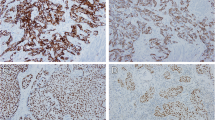Abstract
Urothelial carcinoma is subdivided into luminal (L), basal (B), and p53-wild-type (WT) molecular subtypes, with basal and p53-WT groups showing more aggressive course and poor treatment response, respectively. The literature on molecular subtypes of UC includes a mixture of different stages. We investigated the molecular profile and outcome of pure cohort of muscle invasive bladder carcinoma (MIBC) considering two distinct patterns of muscularis propria (MP) invasion. Forty-three cystectomies harboring stage pT2 were retrospectively identified in 18 years. MP invasion was subclassified into patterns 1 (tumor encasing intact detrusor muscle bundles) and 2 (tumor dissecting/replacing detrusor muscle). Using IHC, B/L phenotypes, p53, and Ki67 were assessed, and survival data was collected. Pattern 1 invasion was noted in 16 (37%) and pattern 2 in 27 (63%), with mean age of pattern 1 being 10 years younger. B/L phenotypes were successfully determined in 83.7%; 48.8% and 34.8% revealed L and B phenotypes, respectively (indeterminate phenotype in 16.4%). Pattern 1 was associated with L phenotype (GATA3 and HER-2 expressions: p = 0.02 & p = 0.04, respectively). Ki67 ≥ 5/10HPF was noted in pattern 2 and B phenotype (p = 0.03). B phenotype showed association with p53-WT (p = 0.007). In median follow-up of 60.7 months, 63.6% of pattern 1 cases were alive without disease compared to 32% of pattern 2 (not significant). A panel of CK20 and GATA3 for luminal and CK5/6 and CK14 for basal subtypes can provide reliable molecular classification in UC. Also, morphology of MIBC can predict the molecular phenotype and the behavior of the UC.



Similar content being viewed by others
References
Bhanvadia SK (2018) Bladder cancer survivorship. Curr Urol Rep 19(12):111
Izquierdo L, Bolton DM, Lawrentschuk N (2013) Radical cystectomy and orthotopic bladder substitution: surgical tricks and management of complications. Minerva Urol Nefrol 65(4):225–234
Malayeri AA, Pattanayak P, Apolo AB (2015) Imaging muscle-invasive and metastatic urothelial carcinoma. Curr Opin Urol 25(5):441–448
Mari A, Campi R, Tellini R et al (2018) Patterns and predictors of recurrence after open radical cystectomy for bladder cancer: a comprehensive review of the literature. World J Urol 36(2):157–170
Correction to Lancet Infectious Diseases 2020; published online April 29. https://doi.org/10.1016/S1473-3099(20)30064-5. Lancet Infect Dis. 2020;20(7):e148
Choi W, Porten S, Kim S et al (2014) Identification of distinct basal and luminal subtypes of muscle-invasive bladder cancer with different sensitivities to frontline chemotherapy. Cancer Cell 25(2):152–165
Damrauer JS, Hoadley KA, Chism DD et al (2014) Intrinsic subtypes of high-grade bladder cancer reflect the hallmarks of breast cancer biology. Proc Natl Acad Sci USA 111(8):3110–3115
Marzouka NA, Eriksson P, Rovira C, Liedberg F, Sjödahl G, Höglund M (2018) A validation and extended description of the Lund taxonomy for urothelial carcinoma using the TCGA cohort. Sci Rep 8(1):3737
Zhu S, Yu W, Yang X, Wu C, Cheng F (2020) Traditional classification and novel subtyping systems for bladder cancer. Front Oncol 10:102
Rebola J, Aguiar P, Blanca A et al (2019) Predicting outcomes in non-muscle invasive (Ta/T1) bladder cancer: the role of molecular grade based on luminal/basal phenotype. Virchows Arch 475(4):445–455
Cheng L, Neumann RM, Scherer BG et al (1999) Tumor size predicts the survival of patients with pathologic stage T2 bladder carcinoma: a critical evaluation of the depth of muscle invasion. Cancer 85:2638–2647
Amin M (2009) Histological variants of urothelial carcinoma: diagnostic, therapeutic and prognostic implications. Mod Pathol 22:96–118
Langner C, Hutterer G, Chromecki T, Rehak P, Zigeuner R (2006) Patterns of invasion and histological growth as prognostic indicators in urothelial carcinoma of the upper urinary tract. Virchows Arch 448(5):604–611
Denzinger S, Burger M, Fritsche HM et al (2009) Prognostic value of histopathological tumour growth patterns at the invasion front of T1G3 urothelial carcinoma of the bladder. Scand J Urol Nephrol 43:282–287
Jimenez RE, Gheiler E, Oskanian P et al (2000) Grading the invasive component of urothelial carcinoma of the bladder and its relationship with progression-free survival. Am J Surg Pathol 24(7):980–987
Chatterjee D, Bansal V, Malik V et al (2019) Tumor budding and worse pattern of invasion can predict nodal metastasis in oral cancers and associated with poor survival in early-stage tumors. Ear Nose Throat J 98(7):E112–E119
AJCC Cancer Staging Manual (8th edition). Springer International Publishing: American Joint Commission on Cancer; 2016 Dec 28
Lindgren D, Sjödahl G, Lauss M et al (2012) Integrated genomic and gene expression profiling identifies two major genomic circuits in urothelial carcinoma. PLoS ONE 7(6):e38863. https://doi.org/10.1371/journal.pone.0038863
Dadhania V, Zhang M, Zhang L et al (2016) Meta-analysis of the luminal and basal subtypes of bladder cancer and the identification of signature immunohistochemical markers for clinical use. EBioMedicine 12:105–117. https://doi.org/10.1016/j.ebiom.2016.08.036
Guo CC, Bondaruk J, Yao H et al (2020) Assessment of luminal and basal phenotypes in bladder cancer. Sci Rep 10(1):9743
Acknowledgements
The authors wish to appreciate the efforts of all colleagues who contributed to this study, including Pallavi Patel, MD; Kara Lombardo; Dongfang Yang, Ashley Sturtevant, and other members of Pathology Research Laboratory in Lifespan/Rhode Island Hospital.
Author information
Authors and Affiliations
Contributions
Dr. Haghayeghi gathered the preliminary immunohistochemical data and provided the preliminary manuscript draft and data. Drs. Lu and Leonhard conducted statistical analysis of the study; Drs. Andres Matoso, Schiff, and Amin were involved in data interpretation, analysis of study findings, and review of the manuscript. Dr Amin also oversaw immunohistochemical interpretation and revisions of the manuscript.
Corresponding author
Ethics declarations
Consent to participate
For this type of study, formal consent is not required.
Conflict of interest
The authors declare no competing interests.
Additional information
Publisher’s note
Springer Nature remains neutral with regard to jurisdictional claims in published maps and institutional affiliations.
The abstract of this study was presented at the 109th United States and Canadian Academy of Pathology (USCAP) Meeting.
Rights and permissions
About this article
Cite this article
Haghayeghi, K., Lu, S., Matoso, A. et al. Association of current molecular subtypes in urothelial carcinoma with patterns of muscularis propria invasion. Virchows Arch 479, 515–521 (2021). https://doi.org/10.1007/s00428-021-03145-y
Received:
Revised:
Accepted:
Published:
Issue Date:
DOI: https://doi.org/10.1007/s00428-021-03145-y




